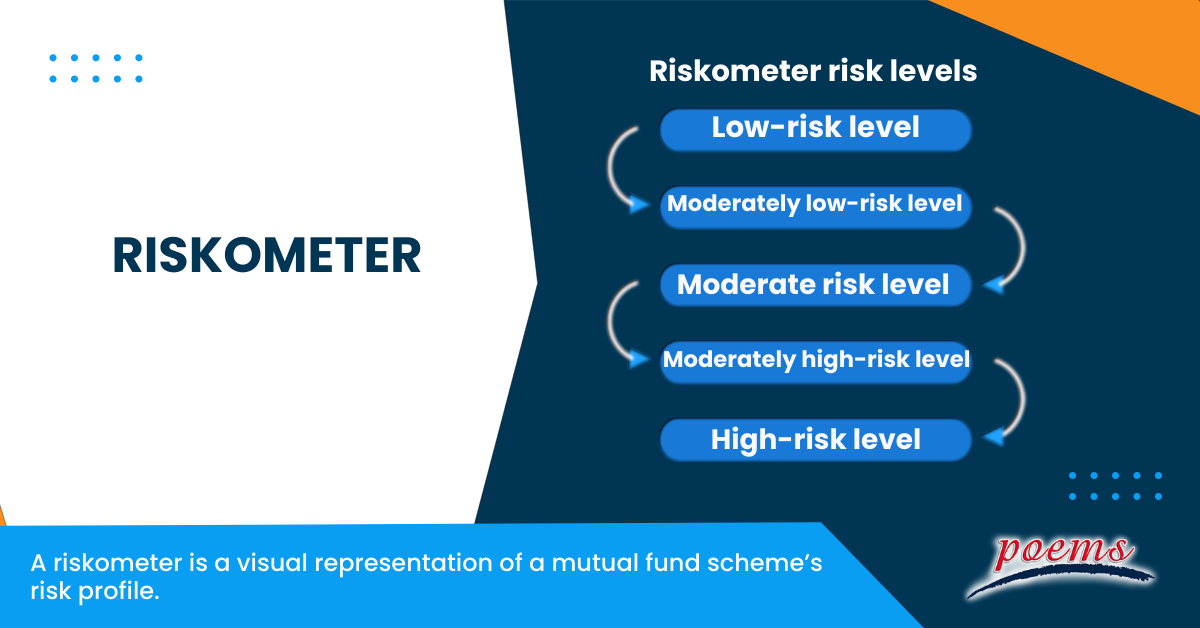Riskometer
Table of Contents
Riskometer
Like all other investment instruments, mutual funds also carry some risk. Weighing these risks is essential before investing. Usually, an investor’s level of risk tolerance is taken into account when making investing selections. A riskometer for mutual funds can help you with this.
What is a riskometer?
A riskometer is a visual representation of a mutual fund scheme’s risk profile. It demonstrates the degree of risk connected to the initial investment made in a mutual fund. Five levels make up the riskometer: low, substantially low, moderate, moderately high, and high.
Investors may use a riskometer as a part of their metrics to choose mutual funds that match their degrees of risk tolerance, given the wide range of mutual funds available. Investors who want to evaluate the fund’s risk levels and determine if they match their own might benefit from this indicator.
Understanding a riskometer
Investors can use a riskometer as one of their criteria to choose mutual funds that match their degree of risk tolerance, given the wide range of mutual funds available. Investors who want to evaluate the fund’s risk levels and determine whether they match their own can benefit from this indicator.
It is vital to remember that while the riskometer can give an overview of the risk level, it cannot be the only factor considered when choosing a fund to invest in. When choosing a fund, you should consider several other factors, like your investment objective, time horizon, past performance, etc.
Riskometer risk levels

There are five risk levels in the riskometer. It displays the scheme’s level of risk and is designed to resemble a speedometer. The five risk categories are:
- Low-risk level
This category typically includes securities and products, including fixed maturity plans, gilt funds, and income funds. These mutual funds are considered the safest, making them ideal for investors searching for reliable income.
- Moderately low-risk level
Bonds with a short to medium term are typically included in this group. They are suitable for investors who can commit to a position for one to three years and are considered safe investments.
- Moderate risk level
It means that the principle of the funds in this category is at moderate risk. Arbitrage funds, MIP funds, and hybrid debt-oriented funds are suitable for semi-conservative investors who wish to limit risk while still booking respectable profits. These funds are appropriate for investors with a medium- to long-term time horizon.
- Moderately high-risk level
The principle of the funds in this category is at fairly high risk. This category typically includes gold ETFs, diversified equity funds, balanced equity-oriented funds, and index funds. Investors looking to build wealth over an extended period might consider the products sold under this brand. These funds invest in equity, which is tied to the large-cap market.
- High-risk level
This designation indicates that the principal of the funds falling under this category is highly risky. Examples of funds that fall under this category include sectoral, thematic, international, and micro-cap funds. Products bearing this designation are appropriate for investors who want to build wealth over an extended period and are comfortable taking a significant risk on their investment.
Types of risks in mutual funds measured by riskometer
Here are five different risks that can impact your portfolio of mutual funds.
- Market hazard
Loss of all or a portion of your capital is a possibility. As markets change, the value of your mutual funds may decrease.
- Risk of inflation
The potential loss of buying power If the cost of living increases by 2% and your mutual funds gain 5% annually, your real return is only 2%.
- Interest rate uncertainty
Increasing interest rates may result in a value reduction for your mutual funds. Bond mutual funds may experience a decline due to falling bond prices when interest rates rise.
- Financial risk
Your benefits may be diminished if the exchange rate declines (or add to losses). A drop in foreign currency can lower your profits when converted back into Canadian dollars, even if the value of a fund denominated in that currency increases.
- Credit danger
A bond or other security issuer may not have enough cash to pay interest or redeem the bonds for face value when they’re due. Higher default risk securities typically offer higher rewards.
Frequently Asked Questions
The riskometer graphically represents a mutual fund’s risk. It has a speedometer-like appearance and shows five risk categories, each with a corresponding color.
The six levels of the new Riskometer’s pictorial depiction, which range from green for little risk to dark red for very high risk, are each denoted by a color, a number, or both. The Riskometer’s needle position indicates the degree of risk a fund is exposed to.
By deducting the risk-free rate of return (the yield on a US Treasury bond) from the return on investment and dividing the result by the investment’s standard deviation of return, the fund level risk is determined.
You can check the risk level of the scheme from the riskometer and choose the fund accordingly if you have a low-risk tolerance and don’t want to be exposed to market volatility. As a result, it is highly helpful to investors when choosing the finest fund for their portfolio.
Risk assessment methods for mutual funds are:
- Beta
- Alpha
- R Squared
- Typical Deviation
- The Sharpe Ratio
- Sortino Ratio.
Related Terms
- Trailing Stops
- Exchange Control
- Relevant Cost
- Dow Theory
- Hyperdeflation
- Hope Credit
- Futures contracts
- Human capital
- Subrogation
- Qualifying Annuity
- Strategic Alliance
- Probate Court
- Procurement
- Holding company
- Harmonic mean
- Trailing Stops
- Exchange Control
- Relevant Cost
- Dow Theory
- Hyperdeflation
- Hope Credit
- Futures contracts
- Human capital
- Subrogation
- Qualifying Annuity
- Strategic Alliance
- Probate Court
- Procurement
- Holding company
- Harmonic mean
- Income protection insurance
- Recession
- Savings Ratios
- Pump and dump
- Total Debt Servicing Ratio
- Debt to Asset Ratio
- Liquid Assets to Net Worth Ratio
- Liquidity Ratio
- Personal financial ratios
- T-bills
- Payroll deduction plan
- Operating expenses
- Demand elasticity
- Deferred compensation
- Conflict theory
- Acid-test ratio
- Withholding Tax
- Benchmark index
- Double Taxation Relief
- Debtor Risk
- Securitization
- Yield on Distribution
- Currency Swap
- Overcollateralization
- Efficient Frontier
- Listing Rules
- Green Shoe Options
- Accrued Interest
- Market Order
- Accrued Expenses
- Target Leverage Ratio
- Acceptance Credit
- Balloon Interest
- Abridged Prospectus
- Data Tagging
- Perpetuity
- Hybrid annuity
- Investor fallout
- Intermediated market
- Information-less trades
- Back Months
- Adjusted Futures Price
- Expected maturity date
- Excess spread
- Quantitative tightening
- Accreted Value
- Equity Clawback
- Soft Dollar Broker
- Stagnation
- Replenishment
- Decoupling
- Holding period
- Regression analysis
- Wealth manager
- Financial plan
- Adequacy of coverage
- Actual market
- Credit risk
- Insurance
- Financial independence
- Annual report
- Financial management
- Ageing schedule
- Global indices
- Folio number
- Accrual basis
- Liquidity risk
- Quick Ratio
- Unearned Income
- Sustainability
- Value at Risk
- Vertical Financial Analysis
- Residual maturity
- Operating Margin
- Trust deed
- Leverage
- Profit and Loss Statement
- Junior Market
- Affinity fraud
- Base currency
- Working capital
- Individual Savings Account
- Redemption yield
- Net profit margin
- Fringe benefits
- Fiscal policy
- Escrow
- Externality
- Multi-level marketing
- Joint tenancy
- Liquidity coverage ratio
- Hurdle rate
- Kiddie tax
- Giffen Goods
- Keynesian economics
- EBITA
- Risk Tolerance
- Disbursement
- Bayes’ Theorem
- Amalgamation
- Adverse selection
- Contribution Margin
- Accounting Equation
- Value chain
- Gross Income
- Net present value
- Liability
- Leverage ratio
- Inventory turnover
- Gross margin
- Collateral
- Being Bearish
- Being Bullish
- Commodity
- Exchange rate
- Basis point
- Inception date
- Trigger Option
- Zeta model
- Racketeering
- Market Indexes
- Short Selling
- Quartile rank
- Defeasance
- Cut-off-time
- Business-to-Consumer
- Bankruptcy
- Acquisition
- Turnover Ratio
- Indexation
- Fiduciary responsibility
- Benchmark
- Pegging
- Illiquidity
- Backwardation
- Backup Withholding
- Buyout
- Beneficial owner
- Contingent deferred sales charge
- Exchange privilege
- Asset allocation
- Maturity distribution
- Letter of Intent
- Emerging Markets
- Consensus Estimate
- Cash Settlement
- Cash Flow
- Capital Lease Obligations
- Book-to-Bill-Ratio
- Capital Gains or Losses
- Balance Sheet
- Capital Lease
Most Popular Terms
Other Terms
- Physical ETF
- Initial Public Offering
- Buyback
- Secondary Sharing
- Bookrunner
- Notional amount
- Negative convexity
- Jumbo pools
- Inverse floater
- Forward Swap
- Underwriting risk
- Reinvestment risk
- Final Maturity Date
- Payment Date
- Secondary Market
- Margin Requirement
- Mark-to-market
- Pledged Asset
- Yield Pickup
- Subordinated Debt
- Treasury Stock Method
- Stochastic Oscillator
- Bullet Bonds
- Basket Trade
- Contrarian Strategy
- Notional Value
- Speculation
- Stub
- Trading Volume
- Going Long
- Pink sheet stocks
- Rand cost averaging
- Sustainable investment
- Stop-limit sell order
- Economic Bubble
- Ask Price
- Constant prepayment rate
- Covenants
- Stock symbol
- Companion tranche
- Synthetic replication
- Bourse
- Beneficiary
- Witching Hour
- Widow and Orphan stock
- Public Float
- Closing Price
- Reverse stock splits
- Quiet period
- Prepayment risk
Know More about
Tools/Educational Resources
Markets Offered by POEMS
Read the Latest Market Journal

Back in Business: The Return of IPOs & Top Traded Counters in March 2024
Start trading on POEMS! Open a free account here! At a glance: Major indices continue...

Weekly Updates 15/4/24 – 19/4/24
This weekly update is designed to help you stay informed and relate economic and company...

From $50 to $100: Unveiling the Impact of Inflation
In recent years, inflation has become a hot topic, evoking strong emotions as the cost...

Japan’s Economic Resurgence: Unveiling the Tailwinds Behind Nikkei 225’s Record Leap
Source: eSignal, Intercontinental Exchange, Inc. In the heart of Japan’s economic landscape, the Nikkei 225...

Weekly Updates 8/4/24 – 12/4/24
This weekly update is designed to help you stay informed and relate economic and...

What Makes Forex Trading Attractive?
In a world where the click of a button can send goods across oceans and...

Weekly Updates 1/4/24 – 5/4/24
This weekly update is designed to help you stay informed and relate economic and company...

How to soar higher with Positive Carry!
As US Fed interest rates are predicted to rise 6 times this year, it’s best...












